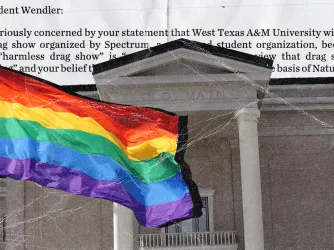Table of Contents
Lawrence Journal-World wrong on flag art censorship at University of Kansas

If you’ve been reading FIRE’s Newsdesk and following our social media accounts this week, you’ve seen the bad news out of the University of Kansas. Late Wednesday, KU removed a public art installation after some, including Kansas Secretary of State Kris Kobach and Governor Jeff Colyer, said the artwork desecrated the American flag.
The artwork in question, “Untitled (Flag 2),” by Josephine Meckseper, uses the American flag as its canvas, and is described by the artist as “a collage of an American flag and one of my dripped paintings which resembles the contours of the United States.” Citing unspecified safety concerns, KU moved the flag from its location outside Spooner Hall to a location inside KU’s Spencer Museum of Art.
That KU cowed to demands for censorship is alarming to FIRE and to other civil liberties watchdogs. It isn’t, however, alarming to the editors of the Lawrence Journal-World. To the contrary, the Journal-World not only commended the censorship, it chastised the university for having displayed the flag in the first place.
Among other things, the Journal-World faults KU for failing to give the community a “clear explanation” of the artwork. This complaint—that an artist supposedly failed to provide proper context or explanation for his or her artwork—is a common and pernicious one in FIRE’s experience, and often used as justification to sterilize or censor art. To be clear: It isn’t incumbent on the artist to “explain” his or her art or to hold audiences’ hands through the process of experiencing it.
As it is, however, there was plenty of explanation provided of the art, which the Journal-World itself notes. The editorial points out that “Untitled (Flag 2)” was part of the nationwide “Pledges of Allegiance” public art project, in which 16 artists contributed flags to be displayed at venues around the country, including the Spencer Museum of Art. The Journal-World also notes that “[t]he flags have been flying one at a time outside Spooner Hall since the art project was launched last year.”
KU has given the community ample explanation and context. Since November, students walking past Spooner Hall have seen numerous flags of varying designs, with varying messages, flying for weeks at a time, acquainting them with the art series and its mission. Further, anyone inclined to walk up to the exhibit could read statements both about the exhibit and the artist whose work was on display. The notion that the community didn’t have a “clear explanation” of the art on display is simply false.
More troubling is the Journal-World’s assertion that KU “should have exercised the good judgment to take the flag down long before the governor demanded it.” This is an ominous statement, one that those in a profession whose currency is the First Amendment should be the last to make. The Journal-World argues that KU should have known that its flag display would be controversial and unpopular, and self-censored accordingly.
We strongly disagree. As we said in our statement Wednesday, the proper course for KU was to stand strong against demands for censorship and to signal to the community and state leaders that it stands by the First Amendment. In failing to do so, it has abdicated its role as the state’s higher education leader, bound to uphold the First Amendment rights of its students and faculty.
KU’s accession to demands for censorship, lauded by the Journal-World, has done little to mollify critics. If anything, it has made them even bolder in their demands for censorship. Secretary Kobach has demanded not just that the artwork be removed from its original location, but from the campus entirely. Governor Colyer has done Kobach one better, suggesting in a radio interview on Fox News that the artwork actually be physically destroyed.
If KU wants to give the community a proper lesson in civic engagement, it should remember the Supreme Court’s ruling in Texas v. Johnson, which invalidated a Texas anti-flag desecration law on First Amendment grounds. In that ruling the Court memorably said, “We do not consecrate the flag by punishing its desecration, for in doing so we dilute the freedom that this cherished emblem represents.” There is still time to heed that lesson, which the last few days have shown is one badly needed in Kansas.
FIRE will continue to report and engage on matters at the University of Kansas. Supporters may also write directly to KU chancellor Douglas Girod and urge the university to restore the flag.
Ask the University of Kansas to restore the artwork
Recent Articles
Get the latest free speech news and analysis from FIRE.

VICTORY! 5th Circuit blocks West Texas A&M’s unconstitutional drag ban

Wide-ranging coalition of 'friends of the court' continue to support citizen journalist Priscilla Villarreal in her return to the Supreme Court

How America’s top tribal arts college silenced a student — and made him homeless
